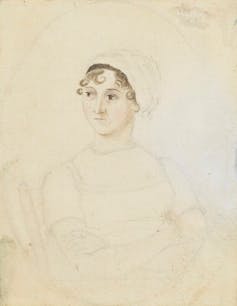Enjoyed together, Red Dwarf and Jane Austen offer a lesson in immersive world building
This year marks the 250th anniversary of Jane Austen’s birth. An Austen enthusiast might attend the birthday ball at the Alton Assembly Rooms in Hampshire or take an Austen-themed walking tour. They might dance at the Pump Rooms in Bath, a city with strong Austen connections, or in Utah, which has none.
These kinds of immersive events tend to surge in times of social and economic fragility. In part, this may be due to a particular form of nostalgia that psychologists have noted helps to mitigate loneliness and forge social connection.
During the pandemic, the Netflix show Bridgerton marked a revival of Austen-adjacent worlds. Fandoms that invite participation function like virtual realities, offering the kind of immersion we might expect from a headset and game console. But is this merely escapism, or do such immersible worlds offer ways of experiencing the present differently and more reflectively?
My first encounter with the immersive potential of Austen came through science fiction. In series seven of Red Dwarf (1997), characters are dispatched into the fictional Pride and Prejudice Land. It’s part of the newly arrived crew member Kristine Kochanski’s (Chloë Annett) favourite game, Jane Austen World – a virtual reality simulation she uses to civilise the other characters.
This article is part of a series commemorating the 250th anniversary of Jane Austen’s birth. Despite having published only six books, she is one of the best-known authors in history. These articles explore the legacy and life of this incredible writer.
Kryten, the service droid, breaks into this Regency idyll aboard a second world war tank and detonates a tea party, roaring “Dinner is served!” The absurdity left a strong impression on my younger self about Austen’s perceived delicacy, and the chaotic energies that surround her cultural afterlives.
Written by Robert Llewellyn (who also plays Kryten), the episode leans hard into domestic satire. Kryten’s female-coded role as cook, cleaner, carer and emotional manager puts him at odds with the interloper Kochanski, a middle-class, degree-educated white woman determined to instil gentility into the racially diverse group who occupy the lowest rung of the ship’s hierarchy.
Kryten’s unvoiced rage culminates in literal explosion, his head detonating when his labour goes unacknowledged. The episode becomes unexpectedly dense: an examination of gender, class, race and post-human servitude. Beneath the explosive humour is a serious comment on immersion and gendered emotional labour.
Austen’s world of tea tables and letter writing, here rendered virtual, is shown to be both seductive and suffocating. It is a place where emotion is both cultivated and dangerously suppressed.
Austen’s claustrophobic worlds
Returning to Austen’s writing at university, I carried my own Dwarf-inspired desire to explode Austen – and to join Mark Twain in a desire to “dig her up and beat her over the skull with her own shin-bone” when I had to read Pride and Prejudice (1813).
I mistakenly believed Austen’s novels offered an obsessive focus on narrow domesticity while ignoring war, revolution, poverty and the illiberal qualities of a supposedly enlightened age. However, in later life I came to realise that, like the confines of a mining ship in deep space, what Austen describes is less small than it is dense and claustrophobic.
A drawing of Jane Austen by her sister, Cassandra.
NPG
Austen’s writing is sharply attentive to the relationship between imaginative freedom and physical constraint, especially for women. Her characters frequently reflect on travel and distance. In Persuasion (1817), Anne Elliot remarks that men “live in the world” while women like herself “live in it only by hearing of it”. In Mansfield Park
(1814), Edmund Bertram jokes that his cousin Fanny Price will “be taking a trip into China” through her reading.
His remark is inflected by Austen including reference to British author Samuel Johnson and his collection The Idler (1760), which Edmund lists among the books he imagines Fanny to be transported by. In an essay from The Idler, Johnson dismisses travel writing as disappointing, failing in immersing the reader for it so often only describes “the face of the country”.
Edmund and Fanny’s conversation takes place in the country house’s East Room, which Austen researchers have described as the most prominent metaphor for Fanny’s “spiritual distance” from the rest of the household. The room is filled with castoffs: faded embroidery, unwanted books, bad portraits. Fanny, too, is a penniless castoff, taken in by wealthier relations but frequently overlooked.
When her uncle sends her back to her lower-class family for refusing a lucrative match, Fanny is punished for her autonomy. She cannot leave Mansfield Park at will, and her imagined departures, whether into books, ideas or “China” – where she might enter a form of narrative virtual reality – offer no protection from real-life threats. Fanny’s reading in the East Room is abruptly curtailed by Edmund’s needs and the encroaching domestic chaos of an amateur theatrical production.
Yet this constraint is part of Austen’s point. The grand estate of Mansfield Park is funded by a shadowy West Indian plantation and enslaved labour, an economic foundation that goes unspoken and unseen. Those who travel there do so off the page.
When Fanny raises the question of the plantation’s ethics, she is met with silence. Who and what is not seen – Fanny, the plantation and its workers, the real costs of luxury – become as significant as what is. Fanny’s room, stripped of wealth, stands in quiet opposition to the brutal source of Mansfield Park’s comforts.
Immersible worlds – whether a Regency ball in Bath, a role in a household play, or a journey into “China” – can be a form of forgetting as much as imagining. The cast at Mansfield throw themselves into Elizabeth Inchbald’s Lovers’ Vows (1798), a sexually suggestive play, with little reflection on how their roles might influence or be influenced by their desires. Fanny, unwilling to participate, sees these risks more clearly, as she does with the larger social problems to which her cousins remain wilfully unseeing.
In Austen’s novels, the immersive imagination is double-edged: it contains the risk of abstraction and of losing touch with the present, even as it offers solace and self-making. What Austen reminds us, then, is to interrogate our relationship with immersible worlds.
As technology brings us ever closer to the virtual realities experienced by the boys from the Dwarf – and as our lived reality is growing more precarious, impoverished and violent – immersible worlds await the careworn. Yet we must beware simply rehearsing the silences which Austen so carefully wrote around.
This article features references to books that have been included for editorial reasons, and may contain links to bookshop.org. If you click on one of the links and go on to buy something from bookshop.org The Conversation UK may earn a commission.
Emma Newport does not work for, consult, own shares in or receive funding from any company or organisation that would benefit from this article, and has disclosed no relevant affiliations beyond their academic appointment.

